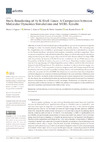Identificador persistente para citar o vincular este elemento:
https://accedacris.ulpgc.es/jspui/handle/10553/77569
| Título: | Stark-broadening of ar k-shell lines: A comparison between molecular dynamics simulations and merl results | Autores/as: | Gigosos, Marco A. Mancini, Roberto C. Martín-González, J.M. Florido, Ricardo |
Clasificación UNESCO: | 220703 Física atómica | Palabras clave: | Electron Broadening Molecular Dynamics Recombination Broadening Simulations Stark Broadening |
Fecha de publicación: | 2021 | Proyectos: | Implementation of activities described in the Roadmap to Fusion during Horizon 2020 through a Joint programme of the members of the EUROfusion consortium Cinética atómica colisional-radiativa y dinámica molecular para la caracterización espectroscópica de plasmas de laboratorio de alta densidad de energía Caracterización espectroscópica de plasmas de laboratorio de alta densidad de energía mediante cinética atómica colisional-radiativa y dinámica molecular |
Publicación seriada: | Atoms | Resumen: | Analysis of Stark-broadened spectral line profiles is a powerful, non-intrusive diagnostic technique to extract the electron density of high-energy-density plasmas. The increasing number of applications and availability of spectroscopic measurements have stimulated new research on line broadening theory calculations and computer simulations, and their comparison. Here, we discuss a comparative study of Stark-broadened line shapes calculated with computer simulations using non-interacting and interacting particles, and with the multi-electron radiator line shape MERL code. In particular, we focus on Ar K-shell X-ray line transitions in He-and H-like ions, i.e., Heα, Heβ and Heγ in He-like Ar and Lyα, Lyβ and Lyγ in H-like Ar. These lines have been extensively used for X-ray spectroscopy of Ar-doped implosion cores in indirect-and direct-drive inertial con-finement fusion (ICF) experiments. The calculations were done for electron densities ranging from 1023 to 3 × 1024 cm−3 and a representative electron temperature of 1 keV. Comparisons of electron broadening only and complete line profiles including electron and ion broadening effects, as well as Doppler, are presented. Overall, MERL line shapes are narrower than those from independent and interacting particles computer simulations performed at the same conditions. Differences come from the distinctive treatments of electron broadening and are more pronounced in α line transitions. We also discuss the recombination broadening mechanism that naturally emerges from molecular dynamics simulations and its influence on the line shapes. Furthermore, we assess the impact of employing either molecular dynamics or MERL line profiles on the diagnosis of core conditions in implosion experiments performed on the OMEGA laser facility. | URI: | https://accedacris.ulpgc.es/handle/10553/77569 | ISSN: | 2218-2004 | DOI: | 10.3390/atoms9010009 | Fuente: | Atoms [EISSN 2218-2004], v. 9 (1), 9, (Enero 2021) |
| Colección: | Artículos |
Citas SCOPUSTM
1
actualizado el 08-jun-2025
Citas de WEB OF SCIENCETM
Citations
1
actualizado el 08-jun-2025
Visitas
169
actualizado el 14-dic-2024
Descargas
113
actualizado el 14-dic-2024
Google ScholarTM
Verifica
Altmetric
Comparte
Exporta metadatos
Los elementos en ULPGC accedaCRIS están protegidos por derechos de autor con todos los derechos reservados, a menos que se indique lo contrario.
